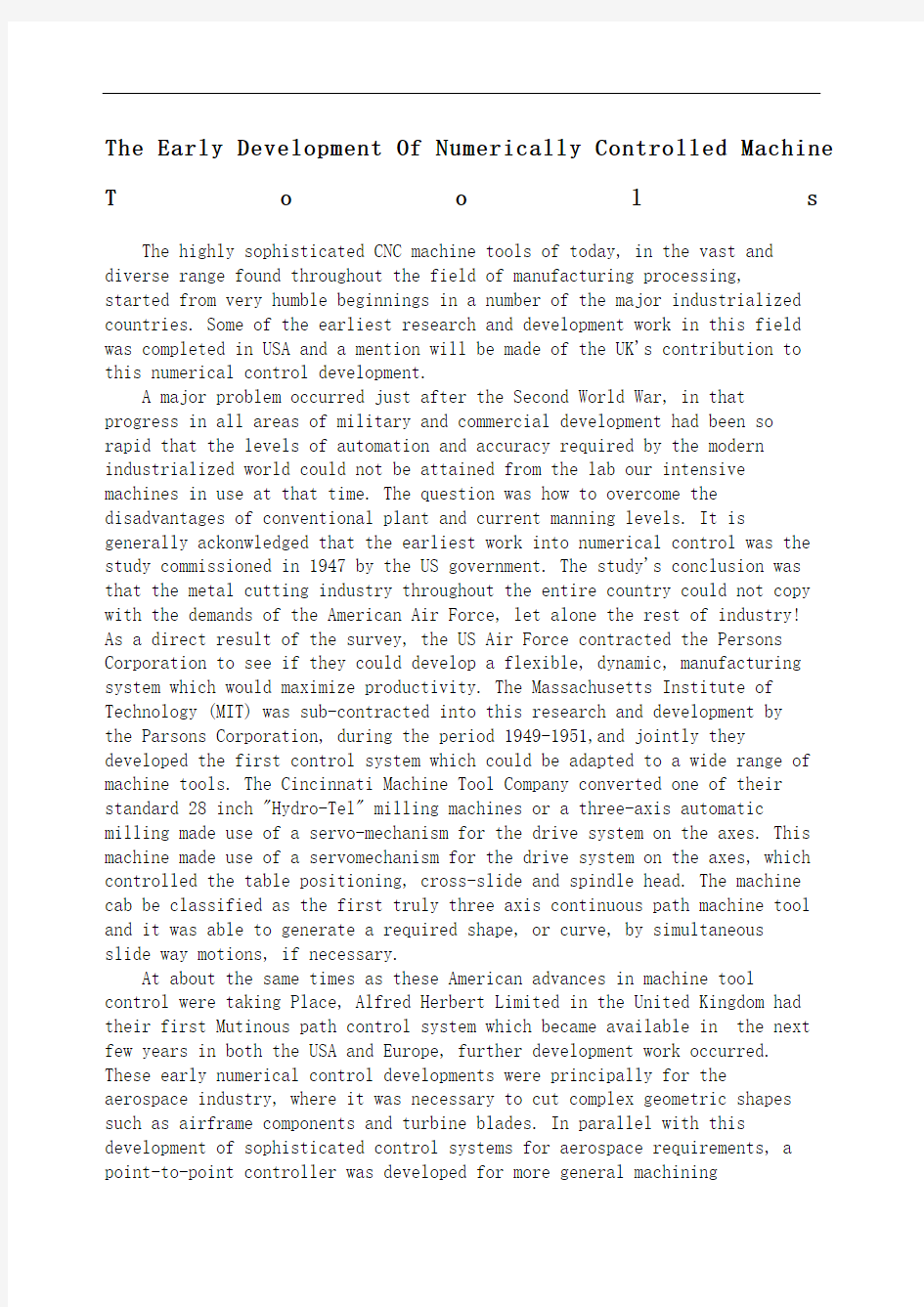

外文翻译车床刀具早期的
发展
Prepared on 22 November 2020
The Early Development Of Numerically Controlled Machine T o o l s
The highly sophisticated CNC machine tools of today, in the vast and diverse range found throughout the field of manufacturing processing,
started from very humble beginnings in a number of the major industrialized countries. Some of the earliest research and development work in this field was completed in USA and a mention will be made of the UK's contribution to this numerical control development.
A major problem occurred just after the Second World War, in that progress in all areas of military and commercial development had been so rapid that the levels of automation and accuracy required by the modern industrialized world could not be attained from the lab our intensive machines in use at that time. The question was how to overcome the disadvantages of conventional plant and current manning levels. It is generally ackonwledged that the earliest work into numerical control was the study commissioned in 1947 by the US government. The study's conclusion was that the metal cutting industry throughout the entire country could not copy with the demands of the American Air Force, let alone the rest of industry! As a direct result of the survey, the US Air Force contracted the Persons Corporation to see if they could develop a flexible, dynamic, manufacturing system which would maximize productivity. The Massachusetts Institute of Technology (MIT) was sub-contracted into this research and development by
the Parsons Corporation, during the period 1949-1951,and jointly they developed the first control system which could be adapted to a wide range of machine tools. The Cincinnati Machine Tool Company converted one of their standard 28 inch "Hydro-Tel" milling machines or a three-axis automatic milling made use of a servo-mechanism for the drive system on the axes. This machine made use of a servomechanism for the drive system on the axes, which controlled the table positioning, cross-slide and spindle head. The machine cab be classified as the first truly three axis continuous path machine tool and it was able to generate a required shape, or curve, by simultaneous
slide way motions, if necessary.
At about the same times as these American advances in machine tool control were taking Place, Alfred Herbert Limited in the United Kingdom had their first Mutinous path control system which became available in the next few years in both the USA and Europe, further development work occurred. These early numerical control developments were principally for the aerospace industry, where it was necessary to cut complex geometric shapes such as airframe components and turbine blades. In parallel with this development of sophisticated control systems for aerospace requirements, a point-to-point controller was developed for more general machining
applications. These less sophisticated point-to-point machines were considerably cheaper than their more complex continuous path cousins and were used when only positional accuracy was necessary. As an example of point-to-point motion on a machine tool for drilling operations, the typical movement might be fast traverse of the work piece under the drill's
position-after drilling the hole, anther rapid move takes place to the next hole's position-after retraction of the drill. Of course, the rapid motion of the slideways could be achieved by each axis in a sequential and independent manner, or simultaneously. If a separate control was utilisec
for each axis, the former method of table travel was less essential to avoid any backlash in the system to obtain the required degree of positional accuracy and so it was necessary that the approach direction to the next point was always the same. The earliest examples of these cheaper point-to-point machines usually did not use recalculating ball screws; this meant
that the motions would be sluggish, and sliderways would inevitably suffer from backlash, but more will be said about this topic later in the chapter. The early NC machines were, in the main, based upon a modified milling machine with this concept of control being utilized on turning, punching, grinding and a whole host of other machine tools later. Towards the end of the 1950s,hydrostatic slideways were often incorporated for machine tools of highly precision, which to sonic extent overcame the section problem associated with conventional slideway response, whiles averaging-out slideway inaccuracy brought about a much increased preasion in the machine tool and improved their control characteristics allows "concept of the machining center" was the product of this early work, as it allowed the machine to manufacture a range of components using a wide variety of machining processes at a single set-up, without transfer of workpieces to other variety machine tools. A machining center differed conceptually in its design from that of a milling machine, In that the cutting tools could be changed automatically by the transfer machanism, or selector, from the magazine to spindle, or vice this ductively and the automatic tool changing feature enabled the machining center to productively and efficiently machine a range of components, by replacing old tools for new, or reselecting the next cutter whilst the current machining process is in cycle.
In the mid 1960s,a UK company, Molins, introduced their unique "System 24" which was meant represent the ability of a system to machine for 24 hours per day. It could be thought of as a "machining complex" which allowed a series of NC single purpose machine tools to be linked by a computerized conveyor system. This conveyor allowed the work pieces to be palletized and then directed to as machine tool as necessary. This was an early, but admirable, attempt at a form of Flexible manufacturing System concept, but was unfortunately doomed to failure. Its principal weakness was that only a small proportion of component varieties could be machine at any instant and that even fewer work pieces required the same operations to be performed on them. These factors meant that the utilization level was low, coupled to the
fact that the machine tools were expensive and allowed frequent production bottlenecks of work-in-progress to arise, which further slowed down the whole operation.
The early to mid-1970s was a time of revolutionary in the area of machine tool controller development, when the term computerized numerical control (CNC) became a reality. This new breed of controllers gave a company the ability to change work piece geometries, together with programs, easily with the minimum of development and lead time, allowing it to be economically viable to machine small batches, or even one-off successfully. The dream of allowing a computerized numerical controller the flexibility and ease of program editing in a production environment became a reality when two ralated factors were:the development of integrated circuits, which reduces electronics circuit size, giving better maintenance and allowing more standardization of desing; that general purpose computers were reduced in size coupled to the fact that their cost of production had fallen considerably.
The multipie benefits of cheaper electorics with greater reliability have result in the CNC fitted to the machine tools today, with the power and sophistication progtessing considerably in the last few years, allowing an almost artificial intelligence(AI) to the latest systems. Over the years, the machine tools builders have produced a large diversity in the range of applications of CNC and just some of those development will be reviewed in
Volume Ⅲ。
With any capital cost item, such as a CNC machine tool, it is necessary for a company to undergo a feasibility study in order to ascertain whether the purchase of new plant is necessary and can be justified over a
relatively short pay-back period. These thoughts and other circial decisions will be the subject of the next section which is concerned with the economic justification for CNC.
车床刀具早期的发展
今天在机器化大生产领域中千形百态,结构复杂的刀具,起源于一些主要的工业国,开始很简陋。这个领域中,最早的一些研究和发展完成于美国,并记载了UK关于发展方面的贡献。第二次世界大战后的一个主要问题是,商业和军队迅速发展,在劳动力密集的加工中,现代工业界所需的自动化与精确度不可获得。问题是怎么样来克服来自常规的加工方法和手工制作的不足。通常认为,关于的研究是1949年美国政府的授权。结论就是致使美国空军与Parsons公司签约,让他们找到一种灵活的、有力的制造
系统,它能扩大生产。麻省理工大学开始进入研究,而Parsons公司使之发展起来。在1949—1951期间,他们联合发明了一种可适合多种刀具的第一个系统。辛辛那提车床刀具公司把他们的一个28英寸的“Hydro—Tel”军用车床改装为三轴自动车床,改变了它们的外部轮廓。在控制桌面位置,典型的车床是三轴连续曲线的车床刀具,它能产生一个所需要的形状或曲线,可能的话,通过一个连续的滑移实现。
与美国车床刀具控制发展的同时,UK中的ALIFRED Herber产生了第一台NC车床。1956年更可靠的曲线路径控制系统开始使用。几年后,在USA与欧洲开始了更深远的研究。早期的发展主要为了航空业,它需要切削加工复杂的几何形状,如机件部件与涡轮机叶片。在航空所需要的复杂的控制系统发展的同时,点与点控制器发展起来,更广泛的用于加工当中。较简单的点与点车床比复杂的连续路径的同类产品便宜一些,并在用于需要精确定位的加工中。作为一个钻操作的车床刀具的点至点移动例子,典型的运动是快速经过在钻主轴下的工件,钻空后,迅速的滑移的运动可能过每轴以连续且独立的方式获得。分开的控制可由每轴完成,在早期的点到点车床中,选取路径不很重要,但它必须避免在获得多需要精度中所产生的冲击。所以,趋势下一点的方向必须是相同的。最早的这些点到点车床长循环的球行螺丝钉,这就意味着那些运动必须很缓慢,移动中遇到的冲击不可避免,关于这个问题下章有更详细的叙述。
早期的NC车床,主要的在磨床基础发展起来的,控制的概念主要用于形成,打孔,磨削以及后来的大量的另外的车床刀具。19世纪50年代以来,流件滑动在高精度的车床中常被结合使用,它在某种程度上克服了常规滑轨相关的问题,然而平均输出导轨的不精确度对刀具要求更高并增加了它的控制特性。
加工中心的概念是早期工作的结果,它允许车床在一个安装上对工件进行多种加工,而不需要把工件转移到另外的刀具下。一个加工中心不同于一个磨床,相互要在于
它能利用转移装置和分离器自动的把切削刀具从刀具库中转移到主轴上。用这种方式,自动换刀特性使这加工中心高效的加工多种部件,用新刀具代替旧刀具或预选刀具,使得现今的加工过程循环操作。
在19世纪60年代中时,一个UK公司,Molins介绍他们独特的“系统24”意思是一天能加工24小时。它可被认为是系列但作用刀具通过计算机上控制的运输系统连接起来的复合车床。这个运输装置让工件放在托盘上送至所需的车床刀具下。这是早期情形,是值得钦佩的。灵活制作系统方面尝试都失败了,它的主要短处是仅仅一小部分的零件种类可随时加工,而更少的工件需要完成于它相同的操作。事实上它的利用水平很低,车床刀具昂贵会导致加工频繁时的“颈瓶”现象,于是进一步限制了整个操作。
13世纪70年代初中叶,是车床刀具控制器变革时期,这个时期,CNC成为了一个现实。新的控制器的产生便使公司可通过改变程序改变了一个工件外形。微型技术的发展,可成功的加工一批或一个2全件。当两个相关的因素存在后,在一个生产环境中,让CNC实现灵活且轻松的编程的梦想变成为现实。这些现实是:
集成电路的发展,它减少了电路的尺寸,使得维护便利且有利于设计的标准化。
计算机的体积减小,从而它的生产费用也极大的降低。价格便宜,性能稳定等多种优点使得今天的CNC安装在车床刀具上。随着它的不断发展成熟,使在高级的CNC系统上可安上人工智能。这些年来,刀具制作者已经制作了多种多样的刀具可用在CNC系统上,其中的一部分在第3册中将被讨论。
由资金耗费项目上的考虑,就CNC车床刀具而言,为了明确新计划是否必要或证明在短期内实现资金回收,一个公司必须进行可行性分析。这些想法及重要的决定将会成为考虑CNC系统经济性调整问题的主题。